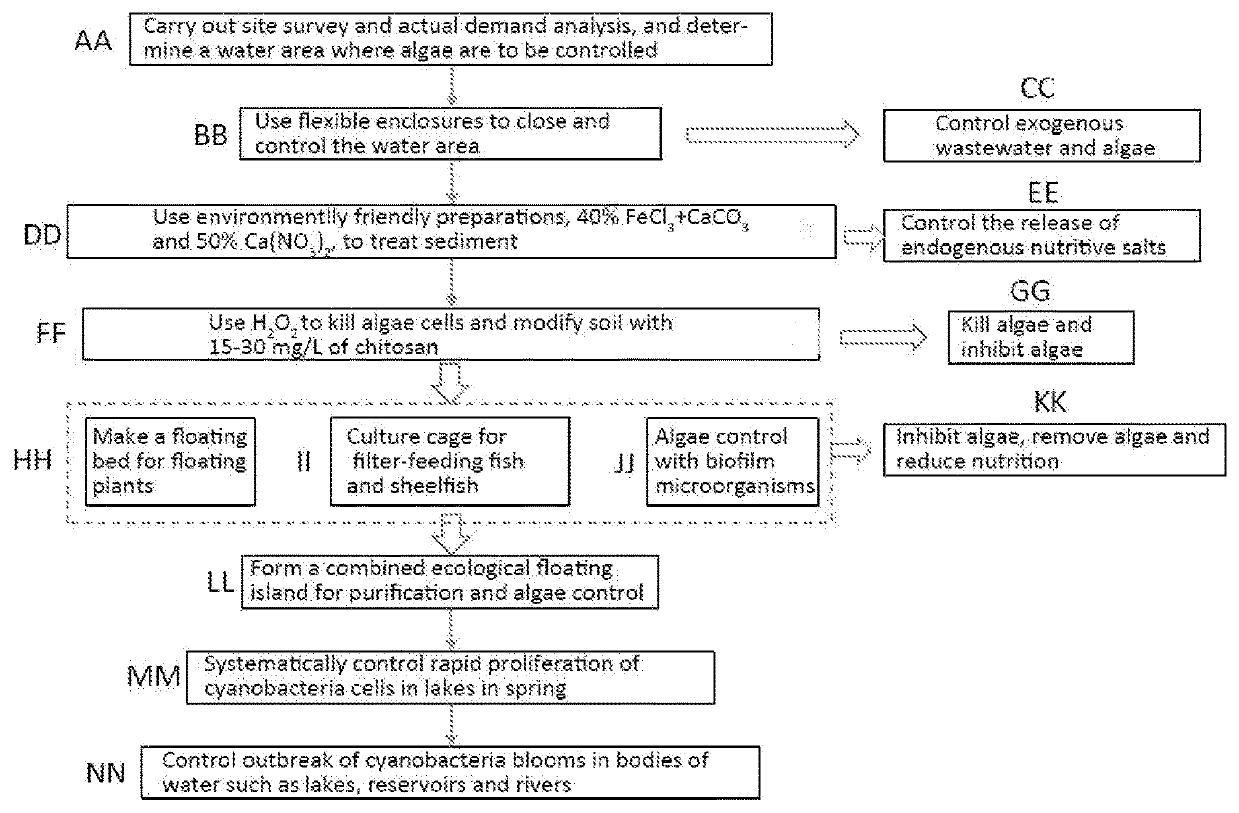Method for systematically controlling rapid proliferation of cyanobacteria cells in lakes in spring
a technology for cyanobacteria cells and spring, applied in biological water/sewage treatment, sustainable biological treatment, multi-stage water/sewage treatment, etc., can solve the problems of serious environmental problems of lakes in our country, affecting the safety of water supply, and the frequency and scale of cyanobacteria bloom outbreaks have not decreased, so as to efficiently, quickly and persistently control the rapid proliferation
- Summary
- Abstract
- Description
- Claims
- Application Information
AI Technical Summary
Benefits of technology
Problems solved by technology
Method used
Image
Examples
embodiment 1
[0024]From March to June 2017, the area within a semi-closed weir in the west half of the Chaohu Lake was selected to carry out a demonstration of algae control technology for the rapid growth period of cyanobacteria.
[0025]Flexible enclosures were used to close three control water areas, each with an area of 600 m2, 1800 m2 in total.
[0026]After completion of the closure of the control water areas, algae control measures were taken for the rapid growth period of cyanobacteria; environmentally friendly chemicals were used first, 40% FeCl3+CaCO3 was injected into the surface sediment to make Fe3+ reach about 300 g / m2 and then 50% Ca(NO3)2 was injected into the surface sediment to make NO3—N reach 10 g / m2 to control the release of phosphorus in the bottom sediment and promote the denitrification process on the sediment surface;
[0027]After completion of the above measures, 10 mg / L H2O2 was used to kill algae cells and then 20 mg / L chitosan modified soil was added to the water body t
embodiment 2
[0034]From March to June 2015, the experimental enclosure ecosystem of the Taihu Station, Nanjing Institute of Geography and Limnology, Chinese Academy of Sciences was selected to carry out a demonstration of algae control technology for the rapid growth period of cyanobacteria. The control effect was observed until August.
[0035]Flexible enclosures were used to close three control water areas, each with an area of 100 m2, 300 m2 in total.
[0036]After completion of the closure of the control water areas, algae control measures were taken for the rapid growth period of cyanobacteria; environmentally friendly chemicals were used first, 40% FeCl3+CaCO3 was injected into the surface sediment to make Fe3+ reach about 300 g / m2 and then 50% Ca(NO3)2 was injected into the surface sediment to make NO3—N reach 12 g / m2 to control the release of phosphorus in the bottom sediment and promote the denitrification process on the sediment surface;
[0037]After completion of the above measures, 15 mg /
embodiment 3
[0044]From March to June 2016, the estuary water area of the Nanfei River into the Chaohu Lake was selected to carry out a demonstration of algae control technology for the rapid growth period of cyanobacteria.
[0045]Flexible enclosures were used to close a control water area, with an area of 10,000 m2. The control effect was observed until September.
[0046]After completion of the closure of the control water area, algae control measures were taken for the rapid growth period of cyanobacteria; environmentally friendly chemicals were used first, 40% FeCl3+CaCO3 was injected into the surface sediment to make Fe3+ reach about 300 g / m2 and then 50% Ca(NO3)2 was injected into the surface sediment to make NO3—N reach 11 g / m2 to control the release of phosphorus in the bottom sediment and promote the denitrification process on the sediment surface; After completion of the above measures, 12 mg / L H2O2 was used to kill algae cells and then 30 mg / L chitosan modified soil was added to the w
PUM
 Login to view more
Login to view more Abstract
Description
Claims
Application Information
 Login to view more
Login to view more - R&D Engineer
- R&D Manager
- IP Professional
- Industry Leading Data Capabilities
- Powerful AI technology
- Patent DNA Extraction
Browse by: Latest US Patents, China's latest patents, Technical Efficacy Thesaurus, Application Domain, Technology Topic.
© 2024 PatSnap. All rights reserved.Legal|Privacy policy|Modern Slavery Act Transparency Statement|Sitemap

